Fantastic Discounts On Oppo Products. Apply discount code OPPO20.
Comparing iPhone 13 and iPhone 11: Is an Upgrade Worth it?
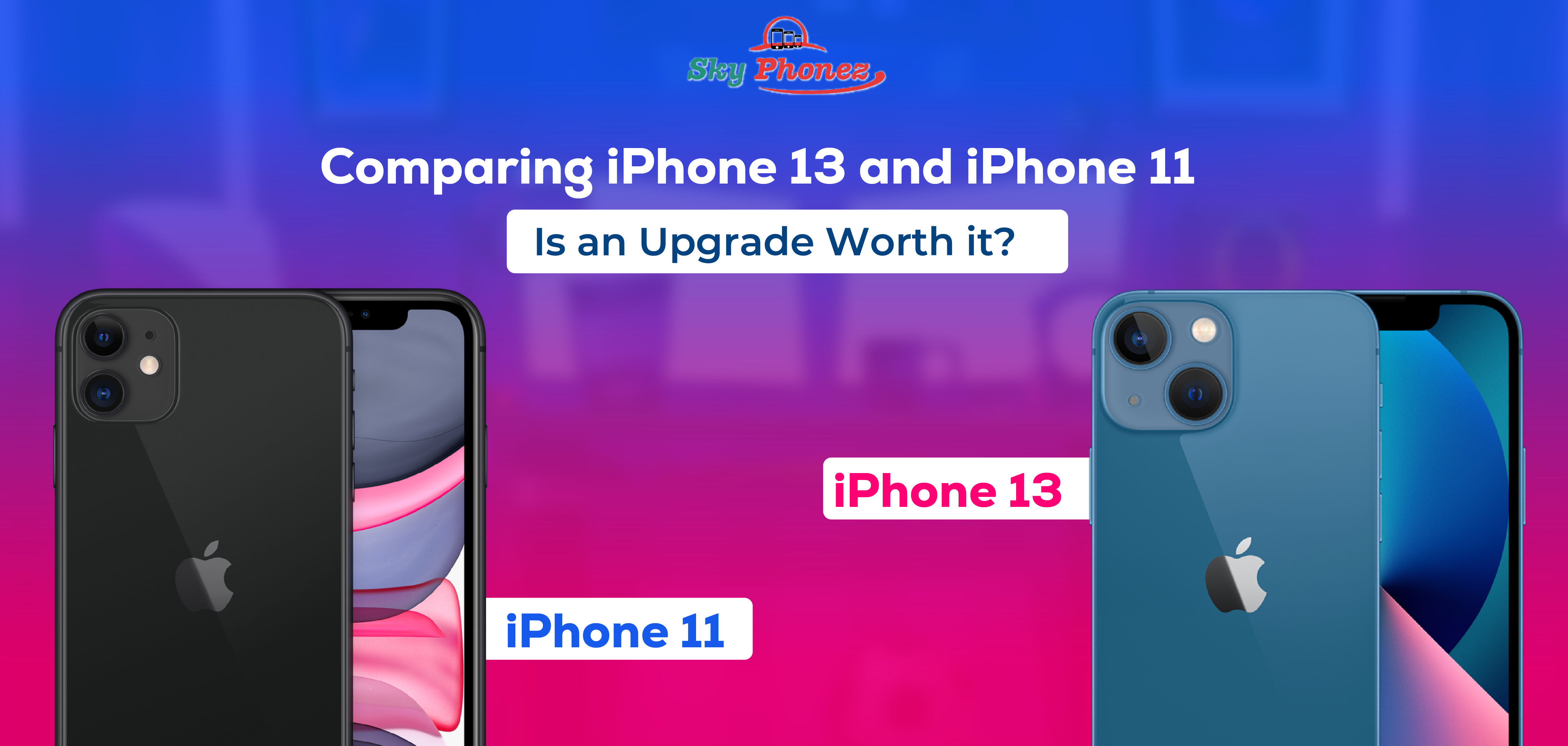
If you are an Apple fan then you might be weighing the iPhone 13 and iPhone 11 to decide if it’s time for an upgrade. Right?
Well, before you take the leap, we will compare and contrast the two brilliant Apple phones so that you can pick the best device as per your preferences.
As technology advances, the iPhone 13 brings to the table a series of enhancements over its predecessor, the iPhone 11.
This blog delves into the various aspects of both devices, comparing design, display, camera capabilities, performance, sound, and overall value to help you make the right move.
Let’s get started.
Key Takeaways
- The iPhone 13 introduced a flat-edge design, smaller borders, and a reduced notch size, along with an OLED screen compared to the iPhone 11’s LCD, offering a more aesthetic and visually immersive experience.
- Camera enhancements in the iPhone 13 include improved sensors, photographic styles, and advanced video features like Night mode, making it a significant step up from the iPhone 11 in terms of photography and videography.
- Performance-wise, the A15 Bionic chip in the iPhone 13 outshines the A13, delivering faster processing, better efficiency, and longer battery life, which could be a compelling reason for power users to upgrade.
- The iPhone 13 boasts better speaker quality and spatial audio support, with multimedia features like Cinematic mode enhancing the overall audio-visual experience, especially for gaming and watching videos.
- Considering the price point and future software updates, the iPhone 13 offers a strong value proposition and may be a more sensible purchase than the newer iPhone 14, which has similar features but comes at a higher cost.
Design and Display: Aesthetic and Visual Upgrades
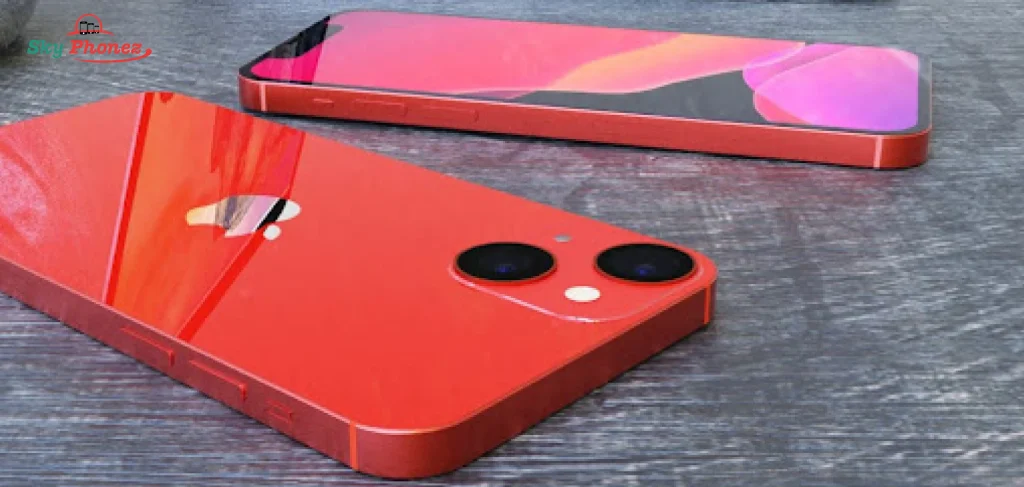
Comparing Form Factors: iPhone 13’s Flat-Edge Design
The iPhone 13 marked a notable shift in Apple’s design philosophy, harkening back to the beloved flat-edge design of earlier models like the iPhone 5. I must admit that this is my favourite design as well.
We have two wins here. One, this design provides a modern aesthetic, and Two, it also offers practical benefits in terms of grip and handling. Users have found that the flat sides present more surface area, making the device easier to hold securely.
In terms of dimensions, both the iPhone 13 and iPhone 11 have rounded corners that follow Apple’s signature curved design. However, when measured as a standard rectangle, the screen sizes differ slightly across models. The iPhone 13 screen size is 6.06 inches, and the iPhone 13 weight is 174 g which is 20 g lighter than the iPhone 11.
The transition to flat edges is not just a visual upgrade but also enhances the user’s tactile experience with the device.
While the overall form factor remains relatively unchanged, the iPhone 13’s design tweaks subtly improve the user experience. The flat-edge design, combined with the ceramic shield front and glossy aluminium body, offers a sleek and durable package that you will certainly appreciate.
Screen Technology: OLED vs LCD
The iPhone 13’s introduction of OLED technology represents a significant leap over the iPhone 11’s LCD display. OLED screens offer deeper blacks, more vibrant colours, and better contrast ratios, dramatically improving the overall visual experience.
The Super Retina and Super Retina XDR displays use organic light-emitting diode (OLED) technology, which allows for thinner, more power-efficient panels that deliver a more dynamic and immersive viewing experience.
While both iPhone models boast impressive screen quality, the differences are notable when comparing them side by side. The iPhone 13’s OLED display not only provides an aesthetic upgrade but also contributes to improved battery life due to the efficiency of OLED pixels, which light up individually and consume less power overall.
HDR Support and Notch Size: Enhanced Viewing Experience
Both the iPhone 13 and iPhone 11 support Dolby Vision, HDR10, and HLG, ensuring a vibrant and dynamic range for video content. However, the iPhone 13 boasts a higher peak brightness of 1,600 nits for HDR content compared to the iPhone 11’s 1,200 nits, making for more vivid and bright visuals, especially in well-lit environments.
The notch, which houses the TrueDepth camera system, is also reduced in size on the iPhone 13. This subtle change offers a slightly larger display area and a more immersive experience. While the difference may not be drastic, it contributes to the overall aesthetic and functional improvements of the newer model.
When considering the upgrade from an iPhone 11 to an iPhone 13, these display enhancements are a key factor to weigh in. The increased brightness and HDR capabilities, along with a smaller notch, provide a more enjoyable and engaging visual experience.
Camera Capabilities: Enhancements from iPhone 11 to iPhone 13
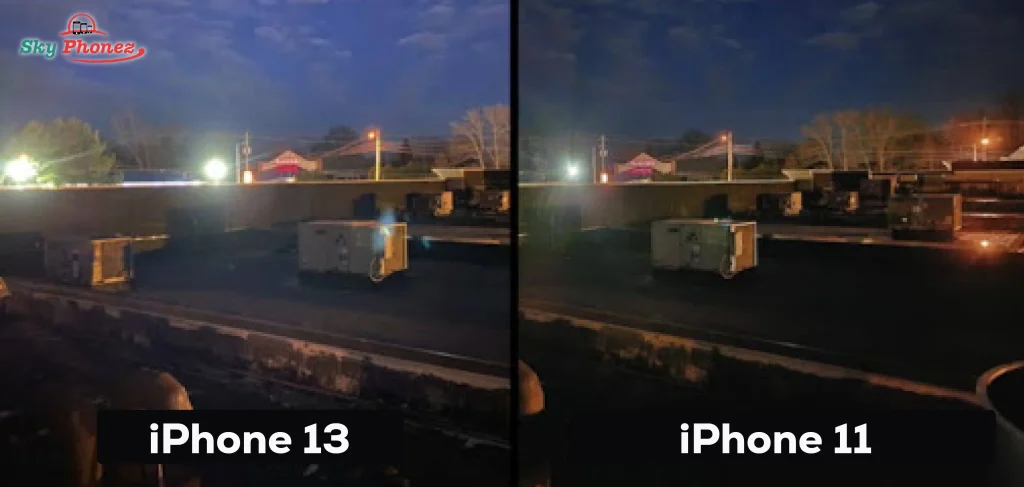
Sensor Improvements and Photographic Styles
The introduction of the second-generation sensor-shift optical image stabilization ensures that even in the most challenging conditions, photos remain sharp and videos are smooth. This feature, previously reserved for DSLR cameras, is now a staple in the iPhone 13’s camera system, allowing for longer exposure times and reduced camera shake.
Photographic Styles bring a new dimension to iPhone photography, enabling users to apply their preferred tonal and colour preferences directly into the image processing pipeline. This means that the styles are intelligently applied to the image while preserving skin tones, offering a personalized look without the need for post-processing.
The iPhone 13’s Night mode has been enhanced, allowing for better low-light photography and night-mode portraits. This improvement is not just about brighter images, but also about maintaining colour accuracy and reducing noise in dimly lit environments.
Macro photography is another interesting area where the iPhone 13 excels, with the ability to capture stunning close-up shots that reveal the intricate details of the subject.
You might be interested: iPhone 13 Series Comparison Guide: Features, Design, and Which Model to Choose
Night Mode and Video Features
The iPhone 13’s Night Mode has been a game-changer for low-light photography, allowing users to capture stunning images in conditions that would have previously resulted in grainy or underexposed photos. The addition of Night Mode Time-lapse brings a new dimension to nighttime video capture, enabling time-lapse videos with dramatically improved clarity and detail.
Photographic Styles, another feature introduced with the iPhone 13, offers a personalised touch to your photos by applying selective adjustments that reflect your preferred aesthetic, without affecting skin tones or sky colours.
The iPhone 13’s advancements in Night Mode and video capabilities significantly enhance the mobile photography and videography experience, making it a compelling reason for users to consider upgrading from the iPhone 11.
While the iPhone 11 does have a Night Mode feature, it lacks the Time-lapse and Photographic Styles options. Below is a comparison of the Night Mode features between the two models:
- iPhone 11: Night Mode for photos
- iPhone 13: Night Mode for photos, Night Mode Time-lapse, Photographic Styles
Comparative Analysis of Camera Performance
When assessing the camera performance of the iPhone 13 against the iPhone 11, it’s clear that Apple has made significant strides in enhancing the photography experience. The iPhone 13’s camera system offers a noticeable improvement in image quality and versatility.
The iPhone 13 introduces a more advanced dual-camera system with larger sensors and sensor-shift optical image stabilization, which were not available on the iPhone 11. This results in better low-light performance and more detailed photos. Additionally, the Photographic Styles feature allows for more creative control, enabling users to personalize their photos with preferred tonal and colour settings.
The iPhone 13’s camera advancements are not just about hardware; software enhancements also play a crucial role in delivering superior image processing and features like Cinematic mode for fantastic video recording.
Here’s a quick comparison of the camera specifications:
| Feature | iPhone 11 | iPhone 13 |
| Main Camera | 12MP, ƒ/1.8 aperture | 12MP, ƒ/1.6 aperture |
| Ultra Wide Camera | N/A | 12MP, ƒ/2.4 aperture |
| Night Mode | Yes (Main) | Yes (Both Cameras) |
| Photographic Styles | No | Yes |
In our opinion, the iPhone 13’s camera system is not only more capable but also provides a more refined user experience. For those who prioritize photography and videography, upgrading to the iPhone 13 could be a worthwhile investment.
Performance and Power: The A15 Bionic Chip
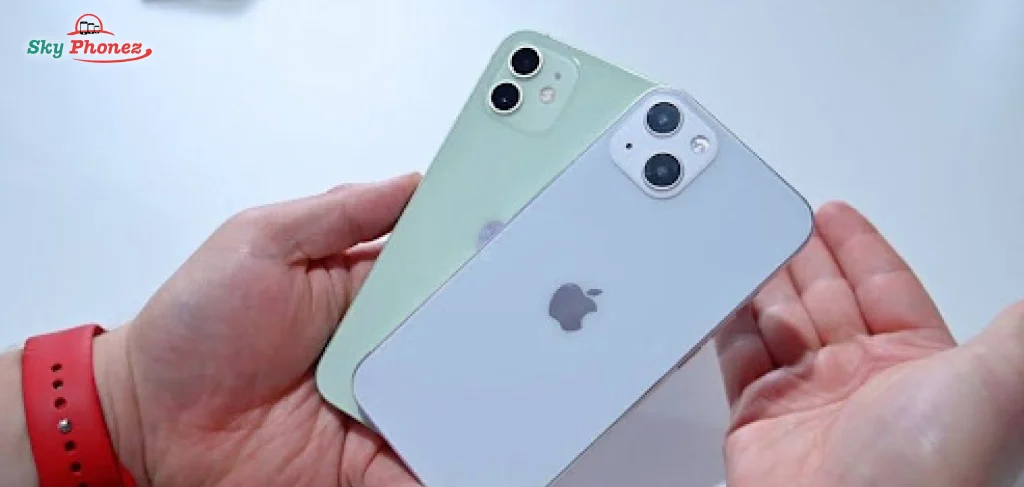
Processor Evolution: A13 vs A15
The transition from the A13 Bionic chip to the A15 Bionic represents a significant leap in processing power for the iPhone series. The A15 chip, which powers the iPhone 13, boasts a 6-core CPU that is expert at handling complex tasks and maintaining efficiency. This upgrade is not just about raw speed; it also enhances the overall user experience with better multitasking and smoother operation of demanding applications.
The A15 Bionic chip’s performance is proof of Apple’s commitment to advancing its technology with each iteration, ensuring that users receive a more responsive and capable device.
While both chips support a 6-core CPU, the A15’s architecture provides a more robust platform for advancements in machine learning and artificial intelligence, thanks to its 16-core Neural Engine. The A15 also features a GPU with more cores in the Pro models, offering a substantial improvement in graphics performance, which is particularly noticeable in gaming and other graphics-intensive tasks.
Here’s a quick comparison of the two processors:
| Feature | A13 Bionic | A15 Bionic |
| CPU Cores | 6-core | 6-core |
| Neural Engine | 8-core | 16-core |
| GPU Cores (Pro Models) | 4-core | 5-core |
The A15’s enhanced capabilities ensure that the iPhone 13 remains a powerful contender in the smartphone market, even as newer models are introduced.
Real-World Performance Implications
When considering the real-world performance of the iPhone 13 compared to the iPhone 11, users will notice a smoother distribution of system tasks. This translates to a more consistent and fluid user experience, with less pronounced spikes in performance that can lead to system lag. However, it’s important to note that the level of perceived change varies depending on individual usage patterns.
The A15 Bionic chip in the iPhone 13 manages more efficient performance, which can result in longer app launch times and lower frame rates while scrolling during extreme cases of performance management. These measures are designed to maintain device integrity over time.
In everyday use, many key areas remain unaffected by performance management, ensuring that essential functions such as cellular call quality, photo and video quality, and GPS performance maintain their high standards. Users can expect reliable performance where it matters most, with the A15 Bionic chip providing a robust foundation for all tasks.
Here’s a quick look at some of the performance implications:
- Longer app launch times
- Lower frame rates while scrolling
- Possible backlight dimming
- Lower speaker volume by up to -3dB
- Gradual frame rate reductions in some apps
Despite these measures, the iPhone 13’s A15 Bionic chip ensures that the most critical aspects of your device’s performance remain unaffected, offering a seamless experience that stands the test of time.
Battery Life and Efficiency Gains
The iPhone 13’s battery life represents a significant improvement over the iPhone 11, reflecting advancements in both hardware efficiency and battery technology. Users can expect up to 2.5 more hours of video playback on the iPhone 13 compared to the iPhone 11, which is a considerable gain for those who consume a lot of media on their devices.
The integration of the A15 Bionic chip not only enhances performance but also optimizes battery usage, resulting in longer battery life without compromising on power.
Battery performance varies based on usage patterns, but the iPhone 13 consistently outperforms the iPhone 11 in most scenarios. This is partly due to the more energy-efficient OLED display and the smart data management features of the newer model.
Here’s a quick comparison of video playback times:
| iPhone Model | Video Playback Time |
| iPhone 11 | Up to 17 hours |
| iPhone 13 | Up to 19 hours |
Sound and Multimedia: Evaluating Audio Improvements
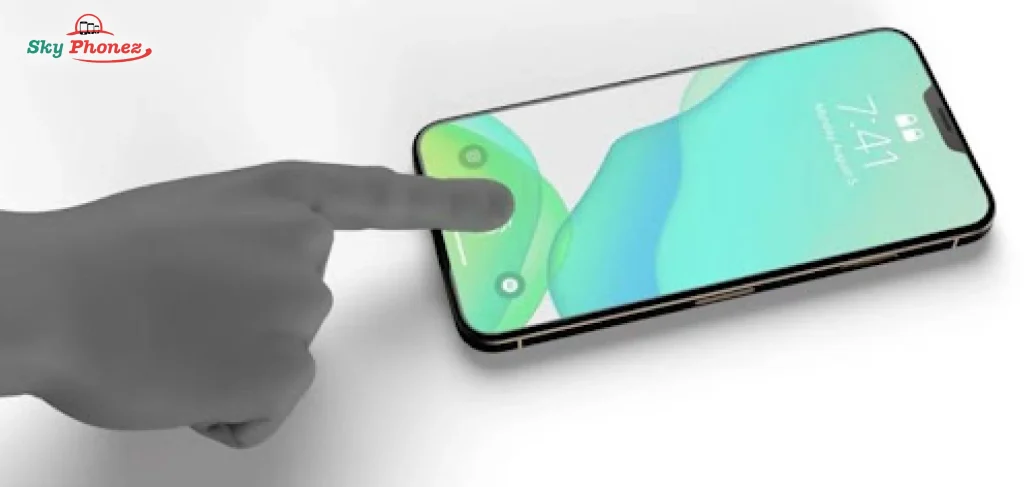
Speaker Quality and Spatial Audio
The iPhone 13’s introduction of Spatial Audio promises to bring exceptional audio experience for users. This feature creates a more immersive sound stage, making it feel as if the audio is coming from all around you. Particularly in Group FaceTime calls, Spatial Audio makes people’s voices sound like they’re coming from the direction in which they’re positioned on the screen, enhancing the sense of presence.
In addition to Spatial Audio, the iPhone 13 also supports Stereo playback, providing a robust and dynamic sound for all types of media. The audio zoom feature, which focuses the microphone on the subject that’s being recorded, further enriches the video-capturing experience.
The iPhone 13’s audio enhancements are not just about increased volume or clarity; they are about creating a more engaging and realistic listening experience that complements the visual upgrades of the device.
Cinematic Mode and Gaming Experiences
The introduction of Cinematic mode on the iPhone 13 has been a game-changer for mobile videography, allowing users to record videos with a shallow depth of field, akin to professional-grade cameras. This feature, which supports up to 4K HDR at 30 fps, provides an enhanced video recording experience that was not available on the iPhone 11.
When it comes to gaming, the iPhone 13’s superior processing power and graphics performance ensure a more immersive and responsive gaming experience. The A15 Bionic chip, coupled with advanced GPU capabilities, translates to smoother gameplay and better handling of complex game graphics.
The combination of Cinematic mode and the iPhone 13’s gaming enhancements offers a compelling reason for users to consider upgrading from the iPhone 11, especially for those keen on multimedia creation and consumption.
Sound Investment: Is the Upgrade Justifiable?
When considering the upgrade from iPhone 11 to iPhone 13, audio improvements are a significant factor. The iPhone 13’s enhanced speaker quality and support for spatial audio provide a more immersive sound experience, whether you’re watching movies, playing games, or listening to music. The addition of Cinematic mode also elevates the multimedia experience, offering a more dynamic and engaging way to consume content.
However, it’s essential to weigh these benefits against the cost of upgrading. For users experiencing very low sound while calling, the iPhone 13’s improved audio capabilities might be a compelling reason to upgrade. But for others, the differences might not justify the expense, especially when considering the iPhone 14 and 15’s incremental updates.
- Enhanced speaker quality and spatial audio support
- Cinematic mode for a more engaging multimedia experience
- Consideration of cost versus audio improvements
While the iPhone 13 presents clear audio advancements, the decision to upgrade should be based on individual needs and the value placed on sound enhancements.
Value Proposition: Assessing the Upgrade’s Worth

Cost-Benefit Analysis: iPhone 13 vs iPhone 11
When assessing the value of upgrading from an iPhone 11 to an iPhone 13, it’s crucial to consider both the financial implications and the technological enhancements. The iPhone 13 is only getting cheaper, and its feature set remains compelling, especially when compared to the newer iPhone models with marginal improvements and higher price tags.
The iPhone 13 offers a significant leap in performance and camera capabilities over the iPhone 11, making it a tempting upgrade for those seeking modern features without breaking the bank.
Here’s a quick breakdown of the cost and benefits:
- Price: The iPhone 13 has seen price reductions, making it more accessible.
- Performance: The A15 Bionic chip in the iPhone 13 offers a substantial performance boost over the A11 in the iPhone 11.
- Camera: Enhanced camera features, including Night mode and Photographic Styles, provide a noticeable improvement in photo and video quality.
- Battery Life: Users can expect longer battery life and more efficient power consumption with the iPhone 13.
Considering these factors, the iPhone 13 stands out as a smart investment for those looking to upgrade from an iPhone 11. It strikes a balance between cost and the latest technological advancements, ensuring users get a modern iPhone experience without the premium price of the newest models.
Longevity and Software Updates
When considering the longevity of an iPhone, software updates play a pivotal role. Apple’s commitment to providing updates has historically extended the life of its devices, ensuring access to the latest features and maintaining security. The iPhone 13, with its advanced hardware, is expected to receive iOS updates for several years, making it a compelling choice for those looking to avoid frequent upgrades.
- iPhone 11: Expected to receive updates until approximately 2023-2024.
- iPhone 13: Expected to receive updates until at least 2025-2026.
The iPhone 13’s superior hardware not only promises a longer support window but also suggests a better performance with future iOS versions. This is crucial for users who rely on their devices for daily tasks and want to ensure a smooth user experience over time.
The potential for the iPhone 13 to support upcoming features, especially those leveraging AI and machine learning, may be limited to older models like the iPhone 11. This could influence the decision to upgrade if staying on the cutting edge of technology is important. However, rumours suggest that Apple may extend software support for older models, which could alter the typical upgrade timeline.
Comparing Alternatives: iPhone 13 vs iPhone 14 and Beyond
When considering an upgrade from the iPhone 11, the iPhone 13 and iPhone 14 are both viable contenders. The iPhone 14 offers incremental improvements, particularly in the realm of camera capabilities. However, the differences may not be substantial enough to warrant the additional cost for every user.
- Price: The iPhone 14 typically comes with a higher price tag.
- Camera: Enhanced settings and features in the iPhone 14 may appeal to photography enthusiasts.
- Design: Both models share a similar aesthetic, making the choice less about looks and more about functionality.
In the rapidly evolving world of technology, the decision to upgrade is often influenced by the promise of future innovations. The iPhone 15, for instance, is rumored to bring significant advancements that could make waiting for its release a more strategic move.
Ultimately, the choice between the iPhone 13 and iPhone 14 boils down to personal preference and the value placed on the latest features. Those seeking the cutting edge may look to the iPhone 15 or beyond, while others might find the iPhone 13 to still be a sound investment.
Conclusion: Weighing the Pros and Cons of Upgrading
In conclusion, the decision to upgrade from an iPhone 11 to an iPhone 13 hinges on individual preferences and needs. The iPhone 13’s OLED display, HDR support, and the advanced A15 chip offer a significant leap in performance and visual experience. However, the iPhone 11 still holds its ground as a capable device. For those seeking the latest technology and improved camera capabilities, the iPhone 13 is a compelling choice. Yet, with the iPhone 14 and 15 now in the market, one must consider whether the incremental updates are worth the investment or if waiting for a more substantial upgrade, like the iPhone 15 with its Dynamic Island and USB-C, is a wiser move. Ultimately, if the iPhone 13’s enhancements align with your usage patterns and you find a good deal, it could be a worthwhile upgrade from the iPhone 11.
Frequently Asked Questions
How big is the iPhone 11?
The iPhone 11 has these dimensions; 150.9 x 75.7 x 8.3 mm (5.94 x 2.98 x 0.33 in). It is a decent-sized phone that is single-hand-use friendly and doesn’t feel bulky as you make long calls on the go. The comfortable iPhone 11 size coupled with solid performance makes it a great choice for budget shoppers.
What are the main design differences between the iPhone 13 and iPhone 11?
The iPhone 13 features a flat-edge design with smaller borders and a smaller notch compared to the iPhone 11’s rounded edges and larger notch. The iPhone 13 also has an OLED screen, while the iPhone 11 has an LCD display.
Does the iPhone 13 have better HDR support than the iPhone 11?
Yes, the iPhone 13 has HDR support which enhances the viewing experience with more vivid colours and higher contrast, while the iPhone 11 does not have this feature.
Are there significant camera improvements from the iPhone 11 to the iPhone 13?
The iPhone 13 boasts sensor improvements, photographic styles, and better night mode and video features, offering a substantial upgrade over the iPhone 11’s camera capabilities.
How does the A15 Bionic chip in the iPhone 13 compare to the A13 in the iPhone 11?
The A15 Bionic chip in the iPhone 13 offers better performance, efficiency, and battery life compared to the A13 chip in the iPhone 11, continuing Apple’s lead in the market with powerful custom silicon.
What audio improvements does the iPhone 13 have over the iPhone 11?
The iPhone 13 improves upon the iPhone 11 with better speaker quality, spatial audio support, and enhanced multimedia features like Cinematic mode for a more immersive audio-visual experience.
Is the iPhone 13 a better value purchase than the iPhone 14?
Considering the similarities in design, display, and processor, and the minor camera improvements, the iPhone 13 offers a better value for its price compared to the iPhone 14, making it a compelling purchase even in 2024.